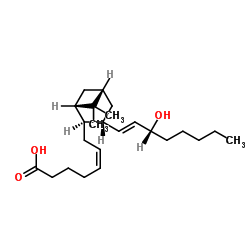PINANE THROMBOXANE A2
Modify Date: 2024-02-02 19:46:49

PINANE THROMBOXANE A2 structure
|
Common Name | PINANE THROMBOXANE A2 | ||
|---|---|---|---|---|
| CAS Number | 71111-01-8 | Molecular Weight | 376.573 | |
| Density | 1.0±0.1 g/cm3 | Boiling Point | 508.6±25.0 °C at 760 mmHg | |
| Molecular Formula | C24H40O3 | Melting Point | N/A | |
| MSDS | N/A | Flash Point | 275.5±19.7 °C | |
Use of PINANE THROMBOXANE A2PTA2 (Pinane thromboxane A2) is a biochemical reagent that can be used as a biological material or organic compound for life science related research. |
| Name | 7-[3-(3-hydroxyoct-1-enyl)-6,6-dimethyl-4-bicyclo[3.1.1]heptanyl]hept-5-enoic acid |
|---|---|
| Synonym | More Synonyms |
| Description | PTA2 (Pinane thromboxane A2) is a biochemical reagent that can be used as a biological material or organic compound for life science related research. |
|---|---|
| Related Catalog |
| Density | 1.0±0.1 g/cm3 |
|---|---|
| Boiling Point | 508.6±25.0 °C at 760 mmHg |
| Molecular Formula | C24H40O3 |
| Molecular Weight | 376.573 |
| Flash Point | 275.5±19.7 °C |
| Exact Mass | 376.297760 |
| PSA | 57.53000 |
| LogP | 7.20 |
| Vapour Pressure | 0.0±3.0 mmHg at 25°C |
| Index of Refraction | 1.532 |
|
Version 1.3
Regulation (EC) No 1907/2006 1 - Product and Company Information Product NamePINANE THROMBOXANE A2 ETHANOL SOLUTION 2 - Hazards Identification SPECIAL INDICATION OF HAZARDS TO HUMANS AND THE ENVIRONMENT Highly flammable. Irritating to eyes, respiratory system and skin.
3 - Composition/Information on Ingredients Product NameCAS #EC noAnnex I Index Number PINANE THROMBOXANE A2 ETHANOL71111-01-8 NoneNone SOLUTION FormulaC24H40O3 Molecular Weight 376,6000 AMU 4 - First Aid Measures AFTER INHALATION If inhaled, remove to fresh air. If breathing becomes difficult, call a physician. AFTER SKIN CONTACT In case of skin contact, flush with copious amounts of water for at least 15 minutes. Remove contaminated clothing and shoes. Call a physician. AFTER EYE CONTACT In case of contact with eyes, flush with copious amounts of water for at least 15 minutes. Assure adequate flushing by separating the eyelids with fingers. Call a physician. AFTER INGESTION If swallowed, wash out mouth with water provided person is conscious. Call a physician. 5 - Fire Fighting Measures SIGMAwww.molbase.com EXTINGUISHING MEDIA Suitable: Carbon dioxide, dry chemical powder, or appropriate foam. SPECIAL PROTECTIVE EQUIPMENT FOR FIREFIGHTERS Wear self-contained breathing apparatus and protective clothing to prevent contact with skin and eyes. 6 - Accidental Release Measures PROCEDURE(S) OF PERSONAL PRECAUTION(S) Wear respirator, chemical safety goggles, rubber boots, and heavy rubber gloves. METHODS FOR CLEANING UP Absorb on sand or vermiculite and place in closed containers for disposal. Ventilate area and wash spill site after material pickup is complete. 7 - Handling and Storage STORAGE Store at -20°C 8 - Exposure Controls / Personal Protection ENGINEERING CONTROLS Mechanical exhaust required. PERSONAL PROTECTIVE EQUIPMENT Special Protective Measures: Wear appropriate government approved respirator, chemical-resistant gloves, safety goggles, other protective clothing. 9 - Physical and Chemical Properties AppearancePhysical State: Liquid PropertyValueAt Temperature or Pressure pHN/A BP/BP RangeN/A MP/MP RangeN/A Flash PointN/A FlammabilityN/A Autoignition TempN/A Oxidizing PropertiesN/A Explosive PropertiesN/A Explosion LimitsN/A Vapor PressureN/A Partition CoefficientN/A ViscosityN/A Vapor DensityN/A Saturated Vapor Conc.N/A Evaporation RateN/A Bulk DensityN/A Decomposition Temp.N/A Solvent ContentN/A Water ContentN/A SIGMAwww.molbase.com Surface TensionN/A ConductivityN/A Miscellaneous DataN/A SolubilityN/A 10 - Stability and Reactivity STABILITY Stable: Stable. HAZARDOUS DECOMPOSITION PRODUCTS Hazardous Decomposition Products: Carbon monoxide, Carbon dioxide. HAZARDOUS POLYMERIZATION Hazardous Polymerization: Will not occur 11 - Toxicological Information ROUTE OF EXPOSURE Multiple Routes: Harmful if swallowed, inhaled, or absorbed through skin. TARGET ORGAN INFORMATION Blood. CONDITIONS AGGRAVATED BY EXPOSURE The toxicological properties have not been thoroughly investigated. 12 - Ecological Information No data available. 13 - Disposal Considerations SUBSTANCE DISPOSAL Dissolve or mix the material with a combustible solvent and burn in a chemical incinerator equipped with an afterburner and scrubber. Observe all federal, state, and local environmental regulations. 14 - Transport Information RID/ADR UN#: 1170 Class: 3 PG: II Proper Shipping Name: Ethanol solution IMDG UN#: 1170 Class: 3 PG: II Proper Shipping Name: ETHANOL SOLUTIONS Marine Pollutant: No Severe Marine Pollutant: No IATA UN#: 1170 Class: 3 SIGMAwww.molbase.com PG: II Proper Shipping Name: Ethanol solution Inhalation Packing Group I: No 15 - Regulatory Information CLASSIFICATION AND LABELING ACCORDING TO EU DIRECTIVES INDICATION OF DANGER: F-Xi Highly Flammable. Irritant. R-PHRASES: 11-36/37/38 Highly flammable. Irritating to eyes, respiratory system and skin. S-PHRASES: 16-26-36 Keep away from sources of ignition - no smoking. In case of contact with eyes, rinse immediately with plenty of water and seek medical advice. Wear suitable protective clothing. Caution: Substance not yet fully tested (EU). 16 - Other Information WARRANTY The above information is believed to be correct but does not purport to be all inclusive and shall be used only as a guide. The information in this document is based on the present state of our knowledge and is applicable to the product with regard to appropriate safety precautions. It does not represent any guarantee of the properties of the product. Inc., shall not be held liable for any damage resulting from handling or from contact with the above product. See reverse side of invoice or packing slip for additional terms and conditions of sale. Copyright 2010 Co. License granted to make unlimitedpaper copies for internal use only. DISCLAIMER For R&D use only. Not for drug, household or other uses. SIGMAwww.molbase.com SECTION 16 - ADDITIONAL INFORMATION N/A |
| Hazard Codes | F,Xi |
|---|---|
| Risk Phrases | 11-36/37/38 |
| Safety Phrases | 16-26-36 |
| RIDADR | UN 1170 3/PG 2 |
| Pinane TXA2 |
| 5-Heptenoic acid, 7-[(1S,2R,3R,5S)-3-[(1E,3R)-3-hydroxy-1-octen-1-yl]-6,6-dimethylbicyclo[3.1.1]hept-2-yl]-, (5Z)- |
| (5Z)-7-{(1S,2R,3R,5S)-3-[(1E,3R)-3-Hydroxy-1-octen-1-yl]-6,6-dimethylbicyclo[3.1.1]hept-2-yl}-5-heptenoic acid |
| 5-Heptenoic acid, 7-[3-[(1E)-3-hydroxy-1-octen-1-yl]-6,6-dimethylbicyclo[3.1.1]hept-2-yl]-, (5E)- |
| (5E)-7-{3-[(1E)-3-Hydroxy-1-octen-1-yl]-6,6-dimethylbicyclo[3.1.1]hept-2-yl}-5-heptenoic acid |